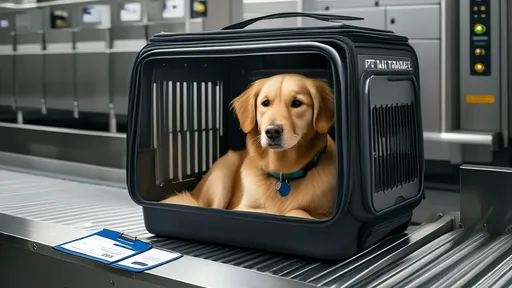Traveling with pets can be a delightful experience, but for some animals, the journey comes with an uncomfortable side effect: motion sickness. Just like humans, dogs and cats can suffer from nausea and dizziness during car rides, making what should be a fun outing into a stressful ordeal. Understanding how to safely administer motion sickness medication to your pet is crucial for their comfort and well-being.
Why Do Pets Get Motion Sickness? Motion sickness in pets occurs when their brain receives conflicting signals from their inner ears, eyes, and body. While the inner ear senses movement, the eyes might not register the same motion if the pet is looking at a stationary object inside the car. This sensory mismatch can lead to nausea, excessive drooling, vomiting, or lethargy. Younger animals are particularly prone to motion sickness because their balance mechanisms are not fully developed, though many outgrow it over time.
Recognizing the Signs Before considering medication, it’s important to identify whether your pet is truly suffering from motion sickness. Common symptoms include restlessness, whining, excessive yawning, drooling, vomiting, or even diarrhea. Some pets may simply lie down and appear lethargic. If these signs occur consistently during travel, motion sickness is likely the culprit. However, if your pet exhibits these behaviors outside of car rides, a veterinary check-up is recommended to rule out other health issues.
When to Consider Medication Not all pets need medication for motion sickness. For mild cases, simple adjustments like limiting food before travel, ensuring proper ventilation, or taking frequent breaks may suffice. However, for pets with severe symptoms, medication can make travel much more comfortable. Always consult your veterinarian before giving any medication, as they can recommend the safest option based on your pet’s age, weight, and health history.
Common Motion Sickness Medications for Pets Several over-the-counter and prescription medications can help alleviate motion sickness in pets. The most commonly recommended include antihistamines like dimenhydrinate (Dramamine) or meclizine (Bonine), which work by blocking the signals that cause nausea. These medications are generally safe when used correctly, but dosage is critical. Never assume that a human dose is appropriate for your pet—always follow veterinary guidance.
Determining the Correct Dosage Dosage depends largely on your pet’s weight and overall health. For example, the typical dose of dimenhydrinate for dogs is 2–4 mg per pound of body weight, given every 8 hours as needed. Cats, however, are more sensitive to medications and require much lower doses. Meclizine is often dosed at 12.5–25 mg for medium to large dogs, but again, this varies. Your vet may also prescribe maropitant (Cerenia), a medication specifically designed for canine motion sickness, which is highly effective and lasts longer than antihistamines.
Potential Side Effects While motion sickness medications are generally safe, they can cause drowsiness, dry mouth, or, in rare cases, hyperactivity. Some pets may also experience gastrointestinal upset. If your pet shows signs of an allergic reaction, such as swelling, difficulty breathing, or severe lethargy, seek veterinary care immediately. It’s always wise to test a small dose at home before a long trip to see how your pet reacts.
Natural Alternatives to Medication For pet owners hesitant about using pharmaceuticals, natural remedies may offer relief. Ginger, for instance, has anti-nausea properties and can be given in small amounts as a treat or supplement. Acupressure bands designed for pets can also help reduce nausea by applying gentle pressure to specific points. Additionally, gradual desensitization—short, positive car trips that slowly increase in duration—can help some pets overcome motion sickness over time.
Pre-Travel Preparations Beyond medication, a few practical steps can minimize motion sickness. Avoid feeding your pet a large meal right before travel, but don’t let them travel on an entirely empty stomach, as this can worsen nausea. Keep the car cool and well-ventilated, and use a secure crate or harness to reduce anxiety and excessive movement. Familiar blankets or toys can provide comfort, while frequent breaks allow your pet to stretch and relax.
When to Seek Veterinary Advice If your pet’s motion sickness is severe or doesn’t improve with medication, consult your vet. Underlying conditions such as ear infections or vestibular disease could be contributing factors. In some cases, prescription anti-anxiety medications may be necessary, especially if stress exacerbates the nausea. Your vet can also rule out more serious issues and tailor a treatment plan to your pet’s specific needs.
Final Thoughts Motion sickness doesn’t have to ruin your pet’s travel experiences. With the right precautions, medication, or natural remedies, you can help your furry companion feel more at ease on the road. Always prioritize safety by consulting your veterinarian before administering any treatment, and pay close attention to your pet’s reactions. A comfortable pet makes for a happier journey—and a happier you.

By /Jul 31, 2025

By /Jul 31, 2025

By /Jul 31, 2025

By /Jul 31, 2025

By /Jul 31, 2025

By /Jul 31, 2025

By /Jul 31, 2025

By /Jul 31, 2025

By /Jul 31, 2025

By /Jul 31, 2025

By /Jul 31, 2025

By /Jul 31, 2025

By /Jul 31, 2025

By /Jul 31, 2025

By /Jul 31, 2025

By /Jul 31, 2025

By /Jul 31, 2025

By /Jul 31, 2025

By /Jul 31, 2025

By /Jul 31, 2025